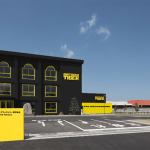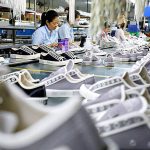
The Timberland Company reported a second-quarter loss of $19.2 million,
or 34 cents a share, versus a deficit of $18.9 million, or 32 cents, a
year ago. Revenue declined 14.4% to $179.7 million, reflecting declines
in Timberland brand apparel and casual footwear. Foreign exchange rate
changes decreased second-quarter 2009 revenue by approximately $11
million, or 5.3%, due to the strengthening of the U.S. dollar relative
to the British Pound and the Euro.
North
America revenue declined 13.3% to $86.3 million, reflecting soft
consumer spending in the U.S. Europe revenue decreased 16.6% to $65.7
million but was down only 2.5% on a constant dollar basis. European
results reflect declines in the apparel, outdoor performance and casual
footwear businesses, partially offset by strong sales of mens and
womens boots. Asia revenue decreased 12.3% to $27.7 million, and
decreased 13.3% on a constant dollar basis, driven by declines in
casual footwear and apparel, partially offset by strengthening of the
mens and womens boots businesses.
Global footwear revenue
decreased 11.2% to $127.0 million, primarily due to declines in the
casual footwear business, which offset strength in the boots business
in the European and Asian markets. Apparel and accessories revenue
decreased 24.6% to $47.2 million, primarily due to softness in the
European market.
Global wholesale revenue decreased 20.3% to
$108.4 million, in part reflecting global financial and credit market
challenges that have caused customers to reduce inventory levels and to
shift from placing future orders to placing at-once orders. Worldwide
consumer direct revenue decreased 3.5% to $71.3 million, reflecting the
adverse impact of a stronger U.S. dollar and a difficult worldwide
retail environment.
Operating loss for the second quarter of
2009 was $36.4 million, compared to a loss of $30.0 million in the
prior year period. In the quarter, there was no material impact from
foreign exchange on operating income.
In the second quarter of
2009, the effective tax rate was 44.3% compared to 36.0% in the second
quarter of 2008. For the full-year 2009, the company anticipates that
its effective tax rate will be approximately 33%.
In connection
with its stock buyback program, Timberland repurchased approximately
700 thousand shares in the second quarter of 2009 at a cost of
approximately $10 million.
Timberland ended the quarter with
$183.9 million in cash and no debt. Inventory at quarter end was $180.4
million, down 7.5% versus 2008 second-quarter levels, reflecting the
companys focus on maintaining clean inventory levels in the face of
challenging market conditions. Accounts receivable decreased 17.6% to
$100.1 million, compared to the prior year.
The company
anticipates that the back half of 2009 will continue to be challenging
due to the low levels of consumer confidence and the financial health
of the global economy. Given the continued volatile nature of current
economic conditions, the company continues to believe there is not
sufficient visibility to set expectations for the remainder of 2009.
Jeffrey
B. Swartz, Timberlands president and CEO, stated, “The first half of
2009 has presented us with unprecedented challenges in the marketplace.
We have tackled the challenges by sharpening our efforts to improve the
overall efficiency of the organization, while recognizing that we must
continue to invest in the long-term health of the brand. The strength
of our balance sheet and our overall liquidity are a real strategic
advantage in this environment. We will continue to invest in key areas
such as product development and marketing that will build the overall
health of the Timberland brand and franchise and leave us
well-positioned when the global economy improves.”















